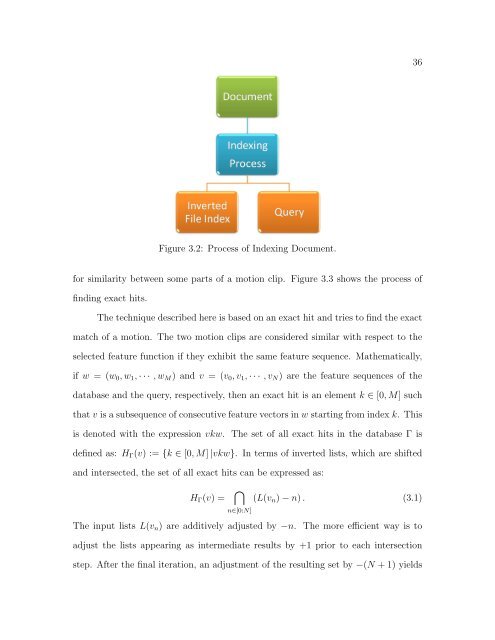A COMPARISON AND EVALUATION OF MOTION INDEXING ...
A COMPARISON AND EVALUATION OF MOTION INDEXING ...
A COMPARISON AND EVALUATION OF MOTION INDEXING ...
Create successful ePaper yourself
Turn your PDF publications into a flip-book with our unique Google optimized e-Paper software.
Figure 3.2: Process of Indexing Document.<br />
for similarity between some parts of a motion clip. Figure 3.3 shows the process of<br />
finding exact hits.<br />
The technique described here is based on an exact hit and tries to find the exact<br />
match of a motion. The two motion clips are considered similar with respect to the<br />
selected feature function if they exhibit the same feature sequence. Mathematically,<br />
if w = (w0, w1, · · · , wM) and v = (v0, v1, · · · , vN) are the feature sequences of the<br />
database and the query, respectively, then an exact hit is an element k ∈ [0, M] such<br />
that v is a subsequence of consecutive feature vectors in w starting from index k. This<br />
is denoted with the expression vkw. The set of all exact hits in the database Γ is<br />
defined as: HΓ(v) := {k ∈ [0, M] |vkw}. In terms of inverted lists, which are shifted<br />
and intersected, the set of all exact hits can be expressed as:<br />
HΓ(v) = <br />
n∈[0:N]<br />
36<br />
(L(vn) − n) . (3.1)<br />
The input lists L(vn) are additively adjusted by −n. The more efficient way is to<br />
adjust the lists appearing as intermediate results by +1 prior to each intersection<br />
step. After the final iteration, an adjustment of the resulting set by −(N + 1) yields
















